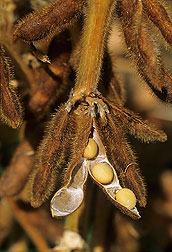Marking Genes for Better Beans

Soybeans, America's second-biggest crop, generate $18 billion annually in farm sales. But about $1 billion worth is lost to soybean cyst nematodes.
The nematodes obstruct the flow of nutrients critical to proper growth and seed development. Farmers plant resistant cultivars, but the pests eventually overcome them by evolving into virulent new forms.
"There's a constant arms race going on between soybeans and cyst nematodes. That's why you have to keep breeding new, resistant varieties," says geneticist David L. Hyten, with ARS's Soybean Genomics and Improvement Laboratory, in Beltsville, Maryland.
For Hyten and research leader Perry B. Cregan, the arms race takes place along stretches of DNA within soybean's 20 chromosomes. Since the 1990s, Cregan has delineated these DNA stretches with simple sequence repeats (SSRs) and single nucleotide polymorphisms (SNPs) to flag the chromosomal whereabouts of desirable genes and their alleles.
Cregan's lab relies on the SNPs to expedite the search for genes that control resistance to pests, including the soybean cyst nematode and soybean rust-a new pathogen on the North American continent.

With new high-throughput SNP marker technology, many hundreds of SNP markers can be analyzed in 3 days on 192 plants of a population resulting from the mating of a disease-resistant soybean with a susceptible one. This process significantly increases the speed and accuracy of discovering DNA signposts closely associated with resistance genes. These signposts can then be readily applied to soybean breeding to rapidly identify plants that carry pest resistance or other desirable quality or productivity traits.
Cregan estimates they've amassed 45,000 markers and mapped the locations of about 15,000 of them. Throughout, his lab has collaborated closely with scientists James E. Specht (University of Nebraska-Lincoln), Randy L. Nelson (ARS, Urbana, Illinois), Randy C. Shoemaker (ARS, Ames, Iowa), H. Roger Boerma (University of Georgia-Athens), Joseph Burton (ARS, Raleigh, North Carolina), Brian W. Diers (University of Illinois at Urbana-Champaign), and others.
The upshot of their efforts will be faster, better, and cheaper soybean breeding for agronomic traits-like mid-oleic oil-and traits for resistance to pests and diseases, such as rust.
"Breeding better beans is really a numbers game," says Hyten. Of thousands of offspring plants that are screened in breeding programs, only a few are chosen for further development as elite cultivars.
"Currently," says Cregan, "we're working to define 50,000 DNA markers in each of the 19,000 soybeans in the USDA Soybean Germplasm Collection so this important resource can be used more efficiently."-Jan Suszkiw, Agricultural Research Service Information Staff.
Agricultural Reasearch magazine, August 2008 Complete Article
